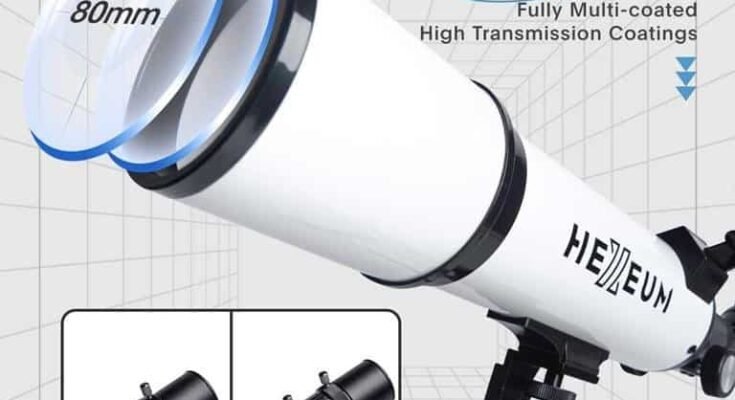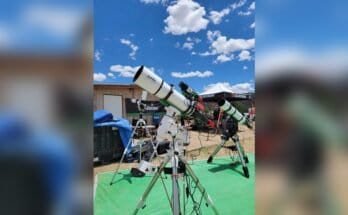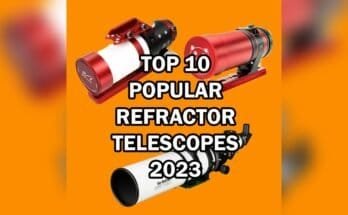Choosing the right refracting telescope can feel overwhelming. You want clear, sharp views of the stars, planets, and distant galaxies—but how do you find the perfect one for your needs?
The good news is, you don’t have to be an expert to pick a great telescope. You’ll discover simple, practical tips to help you understand what matters most when selecting your refracting telescope. By the end, you’ll feel confident making a choice that brings the universe closer to you.
Keep reading to unlock the secrets of finding a telescope that fits your sky-watching dreams perfectly.

Types Of Refracting Telescopes
Refracting telescopes come in different types. Each type has unique features that affect how well you see objects in the sky. Knowing these types helps you choose the right telescope for your needs.
Two main types of refracting telescopes are achromatic and apochromatic. They differ in lens design and image quality. Understanding these differences is key for a clear view.
Achromatic Telescopes
Achromatic telescopes use two lenses to reduce color blur. This design helps focus light better than simple lenses. They are common and usually more affordable.
These telescopes work well for beginners and casual stargazers. Colors may still appear a little fuzzy around bright objects. Still, achromatic models offer good views of the moon and planets.
Apochromatic Telescopes
Apochromatic telescopes use special lenses made from extra-low dispersion glass. These lenses correct color fringing much better than achromatic ones. The result is sharper and clearer images.
These telescopes are popular among serious hobbyists and astrophotographers. They show more detail and true colors of stars and planets. Apochromatic models often cost more but deliver higher quality views.
Key Features To Consider
Choosing the right refracting telescope means knowing what features matter most. Each feature affects how clear and bright the view will be. Understanding these key points helps pick a telescope that suits your needs. This guide covers the most important features to help you decide.
Aperture Size
The aperture size is the diameter of the telescope’s main lens. A larger aperture gathers more light. More light means brighter and clearer images of stars and planets. For beginners, an aperture between 60mm and 90mm works well. Bigger apertures show more detail but can be heavier and cost more.
Focal Length And Ratio
Focal length is the distance light travels inside the telescope. It affects magnification and view size. A longer focal length gives higher magnification but a smaller field of view. The focal ratio is the focal length divided by the aperture. Lower ratios show wider views, good for observing star clusters. Higher ratios suit detailed views of planets.
Lens Quality
Good lens quality reduces distortion and color blur. Look for telescopes with fully coated lenses. Coatings increase light transmission and improve image sharpness. Cheap lenses may cause blurry or colored edges around objects. Choose lenses made from high-quality glass for clear and crisp views.
Mount Types
The mount holds the telescope steady during viewing. There are two main types: altazimuth and equatorial. Altazimuth mounts move up and down, left and right. They are simple and easy for beginners. Equatorial mounts follow the stars’ path across the sky. They are better for long observation sessions and astrophotography.
Setting A Budget
Setting a budget is the first step in choosing a refracting telescope. It helps narrow down options and focus on what fits your needs. A clear budget keeps your search efficient and stress-free. Knowing your spending limit guides you to the right features and quality.
Balancing Cost And Performance
Refracting telescopes vary in price and quality. A higher price often means better lenses and clearer images. But spending too much is not always necessary. Find a balance between cost and performance. Look for a telescope that offers good views without breaking your budget. Basic models work well for beginners and casual stargazers. Advanced features suit those wanting sharper details and more power.
Additional Accessories
Think about extra items that add value. Accessories like eyepieces, filters, and mounts affect total cost. Some telescopes come with basic accessories, but you may want better ones. Budget for these extras to improve your experience. Accessories can enhance image quality and ease of use. A sturdy mount, for example, helps keep the telescope steady. Plan your budget to include these important tools.
Assessing Your Viewing Goals
Choosing a refracting telescope starts with knowing what you want to see. Different telescopes work better for different types of viewing. Understanding your goals helps pick the right one.
Some people enjoy watching planets close up. Others want to explore distant stars and galaxies. Some plan to take photos of the night sky. Each goal needs a specific telescope type and features.
Planetary Observation
Planets are bright and show clear details with good magnification. A refractor with a long focal length helps see rings and moons. Look for sharp, high-contrast lenses. This makes planets like Jupiter and Saturn stand out.
Smaller apertures work well because planets don’t need much light. Easy setup and portability help you observe anytime. Focus on optics that deliver crisp images.
Deep-sky Viewing
Deep-sky objects are faint and far away. Galaxies, star clusters, and nebulae need telescopes with larger apertures. More light means brighter, clearer views of these dim objects.
Choose a refractor with a wide field of view. This helps see more sky at once. Fast optics with low focal ratios bring out detail in faint objects. Stability in the mount is important for steady viewing.
Astrophotography
Astrophotography requires a telescope that works well with cameras. Good optics and a solid mount make a big difference. Refractors with apochromatic lenses reduce color errors in photos.
Look for telescopes with smooth focusing and easy camera attachment. A stable, motorized mount helps track stars precisely. This avoids blurry images during long exposures.
Portability And Storage
Portability and storage are key factors when choosing a refracting telescope. A telescope that is easy to carry makes stargazing more fun. Also, simple storage saves space and keeps your equipment safe.
Consider how often you will move the telescope. A heavy or bulky telescope can become a burden. Small telescopes fit better in cars or backpacks.
Storage space is often limited in homes. A telescope that folds or breaks down is easier to store. It protects lenses from dust and damage.
Size And Weight
Choose a telescope size that suits your needs. Smaller telescopes weigh less and are easier to handle. Large telescopes offer more power but can be heavy.
Check the weight before buying. You want something you can carry without help. A lightweight telescope is better for travel and quick setup.
Design And Portability Features
Look for telescopes with compact designs. Some models have foldable tubes or detachable parts. These features make transport and storage easier.
Consider a telescope with a sturdy but light mount. A simple mount reduces the weight and bulk. It also makes setting up faster.
Storage Options
Find a telescope that fits your storage space. Some come with carrying cases or bags. These protect the telescope and make it easier to store.
Think about a place to keep your telescope safe. Avoid damp or dusty areas. Proper storage helps your telescope last longer.

Common Mistakes To Avoid
Choosing a refracting telescope can be exciting but tricky. Many beginners make common mistakes that affect their experience. Avoiding these errors saves time and money. It helps you enjoy clear views of the night sky.
Knowing these pitfalls helps you pick the right telescope. It also makes your stargazing more fun and less frustrating. Here are some common mistakes to watch out for.
Choosing Too Small An Aperture
Aperture means the diameter of the main lens. A small aperture gathers less light. This results in dimmer and less detailed images. Avoid buying a telescope with too small an aperture.
Opt for a size that fits your viewing needs. Bigger apertures show more stars and planets clearly.
Ignoring The Mount Quality
A shaky or unstable mount ruins your viewing experience. Even a good telescope can give poor images if the mount wobbles. Choose a mount that is sturdy and easy to adjust.
Check for smooth movement and strong support. This keeps the telescope steady during observation.
Overlooking Eyepiece Compatibility
Eyepieces change the magnification of your telescope. Some telescopes only work with specific eyepieces. Make sure the telescope accepts common, easy-to-find eyepieces.
This gives you flexibility to upgrade later. Avoid models with limited or unusual eyepiece sizes.
Focusing Only On Magnification
High magnification sounds good but often lowers image quality. Too much zoom makes images blurry and shaky. Focus on aperture and lens quality first.
Choose a telescope with balanced magnification and clear optics. This gives sharper and more enjoyable views.
Neglecting Portability And Weight
Heavy telescopes are hard to carry and set up. If you travel or move often, pick a lightweight model. Portability makes stargazing easier and more frequent.
Consider size and weight before buying. A heavy telescope might stay unused.
Where To Buy Your Telescope
Choosing where to buy your refracting telescope is important. The place you pick affects the price, quality, and support. Several options are available. Each option suits different needs and budgets. Understanding these choices helps you find the best telescope for stargazing.
Online Retailers
Online stores offer many telescope models. You can compare prices easily. Reviews from other buyers help you decide. Shipping is often fast and convenient. Watch for return policies before buying. Some websites offer bundles with useful accessories. Shopping online saves time and lets you explore many brands.
Specialty Astronomy Shops
Specialty shops focus on telescopes and astronomy gear. Staff usually know a lot and can give advice. You can see the telescope before buying. These stores often offer workshops or classes. Prices may be higher than online but support is better. Buying here helps if you want expert help and hands-on experience.
Secondhand Options
Used telescopes can be cheaper. Check local classifieds or online marketplaces. Inspect the telescope for damage before buying. Sometimes, used models have good quality for less money. Patience is key to find a great deal. This option suits those on a budget or who like hunting for bargains.

Frequently Asked Questions
What Factors Affect Refracting Telescope Performance?
Lens quality, aperture size, and focal length impact image clarity. Higher-quality lenses reduce distortion. Larger apertures gather more light, improving brightness. Longer focal lengths offer greater magnification but narrower views.
How To Choose The Right Aperture For A Refractor?
Choose an aperture based on your observation goals. Larger apertures reveal dimmer objects and finer details. For beginners, 60-90mm apertures balance portability and viewing quality effectively.
Why Is Focal Length Important In Refracting Telescopes?
Focal length determines magnification and field of view. Longer focal lengths provide higher magnification but narrower fields. Shorter focal lengths offer wider views, ideal for scanning star clusters and large celestial objects.
What Eyepiece Types Work Best With Refractors?
Plössl and Orthoscopic eyepieces are popular for refractors. They provide sharp, clear images with minimal distortion. Choose eyepieces with varying focal lengths to adjust magnification easily.
Conclusion
Choosing the right refracting telescope makes stargazing more fun. Think about your budget and how often you will use it. Consider the size and weight for easy handling and storage. Check the lens quality for clear and bright views. Don’t forget to read user reviews for real experiences.
A good telescope fits your needs and helps you explore the night sky. Take your time and enjoy the process of finding the perfect one. Your new telescope will open a world of stars and planets.



